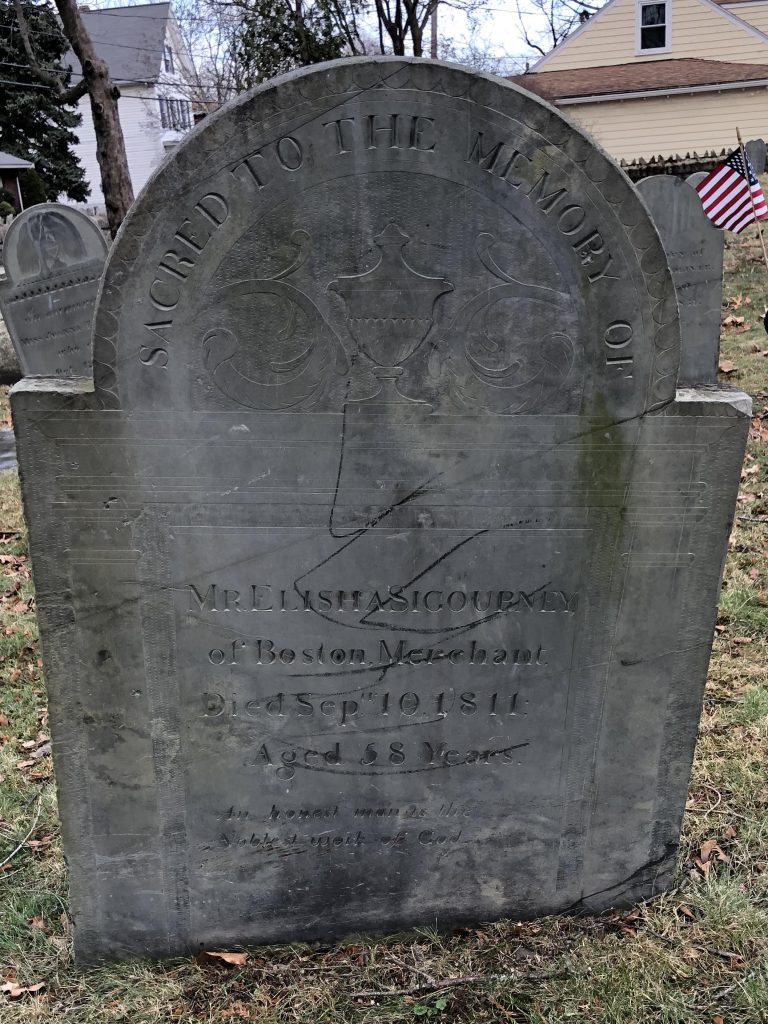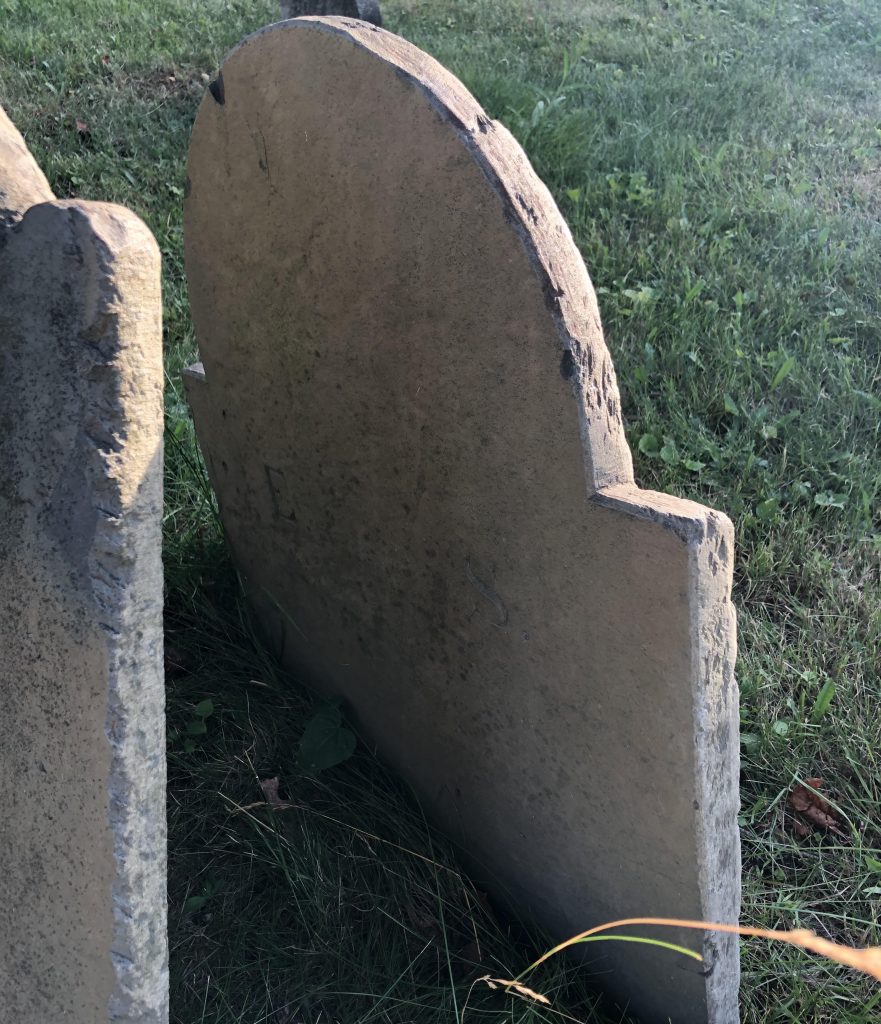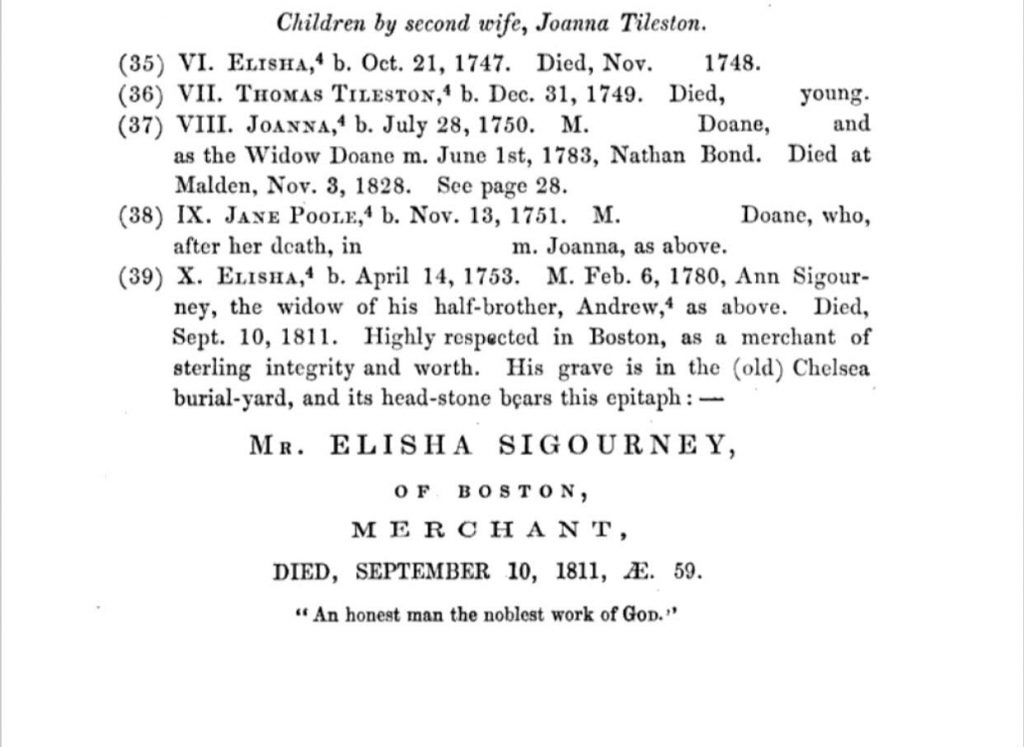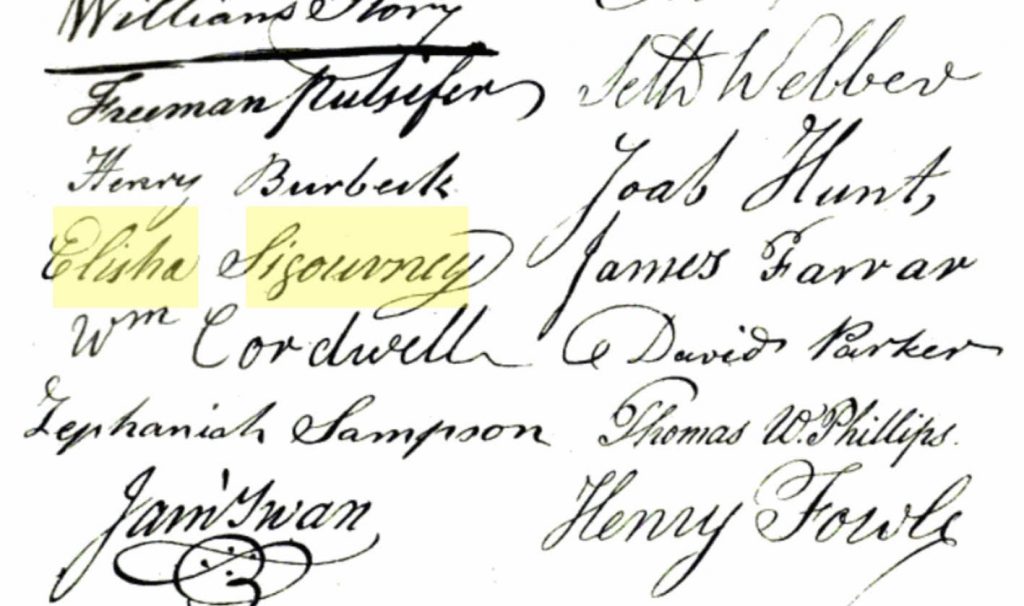One of the first gravestones you may notice in RMBG is the massive stone for Elisha Sigourney, a Boston merchant who died at age 58 on October 10, 1811. Given the size of the stone and the existence of Sigourney Street in Revere I figured he must have been a local figure of some prominence. To my surprise, my usual sources had no information on his life. Benjamin Shurtleff’s 1938 History of Revere includes Sigourney in the list of graves in RMBG, but literally nowhere else. Mellen Chamberlain’s A Documentary History of Chelsea includes Sigourney in a similar list and in only one other place, a mention of his serving as a “referee” of a dispute concerning a new road.

Elisha Sigourney doesn’t really pop up much in other sources either. He’s mentioned several times in the records of the Masonic Lodge of Saint Andrew, and his name appears in a letter from John Quincy Adams to Thomas Boylston Adams concerning the “Gazette of the United States” for which Sigourney managed subscriptions, but I was unable to find any truly detailed account of his life. The book History of The Military Company of the Massachusetts Now Called The Ancient and Honorable Artillery Company of Massachusetts 1617-1888 by Oliver Ayer Roberts offers the following brief description:
Elisha Sigourney (1788), merchant, of Boston, son of Daniel and Mary (Varney) Sigourney, of Boston, was born April 14, 1753. He married Ann —–, who died in Boston, June, 1818, aged seventy-three years. His place of business in 1790 was at No. 1 Spear’s Wharf, and his dwelling-house was in Southac Court, afterwards called Howard Street. He was a great-grandson of Andrew Sigourney, a French Protestant refugee, or Huguenot, who, from devotion to the cause of religious freedom, emigrated to Boston about 1686. Elisha Sigourney (1788) was “a man of strong mind, high sense of honor, scrupulously honest, indefatigable in business. Many of his acts of kindness were so abruptly communicated as to be unthankfully received.” He was much relied upon for his sound judgment in every-day life, and, at his decease, was sincerely mourned by the business and social circles of Boston. Andrew Sigourney (1806) was his nephew.
Mr. Elisha Sigourney (1788) became a member of St. Andrew’s Lodge in 1778, and of St. Andrew’s Royal Arch Chapter, May 28, 1789. He died, highly esteemed, Oct. 10, 1811, and, it is said, “was buried on one of the islands” in Boston Harbor.
Obviously the last line there surprised me, given the pretty clear evidence to the contrary, but the almost total lack of reference to Sigourney in the local history books made me wonder. There are cenotaphs (markers for people whose bodies are elsewhere) in RMBG, so maybe Sigourney’s marker could be one as well. Although it does seem odd that if the marker was only meant to be a cenotaph it would 1. be so large, and 2. have an accompanying footstone (From Slate to Marble attributes the gravestone to carver Levi Maxcy). Since there’s only one way to find out for sure if Elisha Sigourney is buried in RMBG and that’s generally frowned upon, we’ll have to settle for whatever clues we can find through more acceptable methods.

So on one hand, there were cemeteries on the Boston Harbor islands. For example, bodies were buried on Rainsford Island from the 1730s up to 1898, but Wikipedia notes that “most people interred were poor or had died after treatment in the island’s hospitals and many were buried in mass graves.” Hardly the sort of place for a notable Boston merchant to end up. The extremely detailed Find a Grave page for Rainsford Cemetery has no entries for Sigourneys, and the book Rainsford Island: A Boston Harbor Case Study in Public Neglect and Private Activism by William A. McEvoy Jr. and Robin Hazard Ray does not include Sigourney in its list of known burials. While there are other cemeteries on the islands, it is equally unlikely that Sigourney was buried in any of them.
The Vital Records of Chelsea, Massachusetts to the year 1850, compiled by Thomas W. Baldwin and published in 1916, includes a record of Sigourney’s death in 1811. His record includes the abbreviation G.R.1., which stands for what they call the “Revere Cemetery.” RMBG is called Revere Cemetery on the 1897 map, which makes that a clear reference to RMBG.
The Genealogy of the Sigourney Family from 1857 has an entry on Elisha which also has some interesting information. It tells us that Elisha was the son of Daniel Sigourney and his second wife Joanna Tileston, contradicting the Ancient and Honorable Artillery Company description of his parentage (I’m inclined to believe the family genealogy). It also tells us that Elisha married his half-brother Andrew’s widow Ann in 1780, after Andrew was lost at sea “in the winter of 1768-9.” Elisha’s entry concludes with “His grave is in the (old) Chelsea burial-yard” before transcribing his epitaph. At the time of Sigourney’s death Revere was part of Chelsea, and Revere was North Chelsea when this genealogy was written, which would make this another reference to RMBG.

So two reliable sources put Sigourney’s grave in RMBG with no indication that his body ended up somewhere else, which makes the last sentence of that brief biography mystifying. Even the way the sentence is phrased leaves it open to doubt – “it is said” doesn’t provide any source and makes it sound like a rumor. Then the quotes around “was buried on one of the islands in Boston Harbor” reinforce the unreliability of the idea. So where would the idea even come from? The best theory I can come up with is that maybe someone misunderstood a reference to Rumney Marsh. Rumney Marsh was annexed to Boston in 1634, then set off from Boston as Chelsea in 1739, so in 1811 it had probably been some time since the name Rumney Marsh was in common use. It stands to reason that someone who didn’t know would hear “Rumney Marsh” and think of a harbor island locale. Given the available evidence and lack of corroboration for the harbor island claim, I think it’s safe to say that Elisha Sigourney is in fact buried in RMBG.

Researched and written by Brendan O’Brien, July 2020. Gravestone photographs by same.
